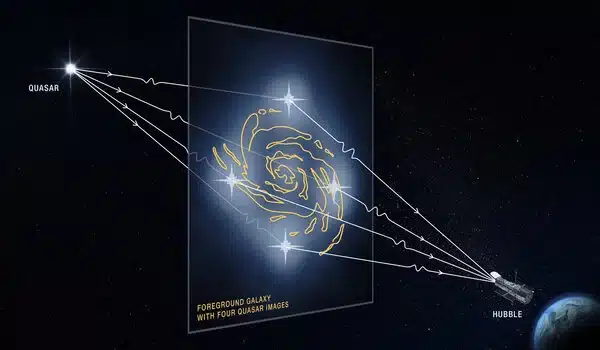Researchers reveal a theoretical discovery that may explain both the nature of invisible dark matter and the cosmic web, the large-scale structure of the universe. The result forges a fresh link between these two long-standing astronomical difficulties, opening up new avenues for comprehending the universe.
According to the findings, the ‘clumpiness problem,’ which concerns the remarkably equal distribution of matter on huge scales throughout the universe, could be a clue that dark matter is made up of hypothetical, ultra-light particles known as axions. The ramifications of confirming the existence of difficult-to-detect axions go beyond comprehending dark matter and may raise basic issues about the nature of the cosmos itself.
Researchers at the University of Toronto unveil a theoretical breakthrough that may explain both the nature of invisible dark matter and the large-scale structure of the universe known as the cosmic web in a study published today in the Journal of Cosmology and Astroparticle Physics. The result forges a fresh link between these two long-standing astronomical difficulties, opening up new avenues for comprehending the universe.
According to the findings, the “clumpiness problem,” which concerns the remarkably equal distribution of matter on huge scales throughout the universe, could be a clue that dark matter is made up of hypothetical, ultra-light particles known as axions. The consequences of demonstrating the existence of difficult-to-detect axions go beyond comprehending dark matter and may address basic concerns about the nature of the cosmos itself.
Finding axion dark matter would be one of the most significant discoveries of this century if confirmed by future telescope observations and lab experiments. At the same time, our results suggest an explanation for why the universe is less clumpy than we thought, an observation that has become increasingly clear over the last decade or so, and which currently leaves our theory of the universe uncertain.
Keir Rogers
“Finding axion dark matter would be one of the most significant discoveries of this century if confirmed by future telescope observations and lab experiments,” says lead author Keir Rogers, Dunlap Fellow at the Dunlap Institute for Astronomy & Astrophysics in the Faculty of Arts & Science at the University of Toronto. “At the same time, our results suggest an explanation for why the universe is less clumpy than we thought, an observation that has become increasingly clear over the last decade or so, and which currently leaves our theory of the universe uncertain.”
Dark matter, which accounts for 85 percent of the mass of the cosmos, is invisible because it does not interact with light. Scientists analyze its gravitational effects on visible matter to learn more about how matter is spread throughout the universe.
According to one leading theory, dark matter is formed of axions, which are described as “fuzzy” in quantum mechanics due to their wave-like behavior. Axions, as opposed to discrete point-like particles, can have wavelengths greater than entire galaxies. This fuzziness effects the production and dispersion of dark matter, which could explain why the cosmos is less clumpy than predicted in an axion-free universe.
This lack of clumpiness has been seen in big galaxy surveys, calling into question the other dominant idea that dark matter is only made up of heavy, weakly interacting subatomic particles known as WIMPs. Despite experiments like as the Large Hadron Collider, no proof for the existence of WIMPs has been discovered.
“In science, it’s when ideas break down that new discoveries are made and age-old problems are solved,” says Rogers.

The research team analyzed observations of relic light from the Big Bang, known as the Cosmic Microwave Background (CMB), obtained from the Planck 2018, Atacama Cosmology Telescope, and South Pole Telescope surveys, led by Rogers and including members of associate professor Renée Hloek’s research group at the Dunlap Institute, as well as from the University of Pennsylvania, Institute for Advanced Study, Columbia University, and King’s College London.
The CMB data were matched to galaxy clustering data from the Baryon Oscillation Spectroscopic Survey (BOSS), which records the positions of about a million galaxies in the surrounding cosmos. By studying the distribution of galaxies, which mirrors the behavior of dark matter under gravitational forces, they measured fluctuations in the amount of matter throughout the universe and confirmed its reduced clumpiness compared to predictions.
The researchers then conducted computer simulations to predict the appearance of relic light and the distribution of galaxies in a universe with long dark matter waves. These calculations aligned with CMB data from the Big Bang and galaxy clustering data, supporting the notion that fuzzy axions could account for the clumpiness problem.
Future study will include large-scale surveys to map millions of galaxies and offer precise measures of clumpiness, including observations with the Rubin Observatory during the next decade. The researchers intend to compare their hypothesis to direct observations of dark matter via gravitational lensing, a phenomenon in which the clumpiness of dark matter is assessed by how much it bends light from distant galaxies, similar to a big magnifying glass. They also intend to explore how galaxies release gas into space and how this impacts the distribution of dark matter to corroborate their findings.
Understanding the nature of dark matter is one of the most important basic mysteries and is critical to understanding the universe’s origin and future.
Scientists now lack a single hypothesis that explains gravity and quantum physics simultaneously – a theory of everything. String theory, which proposes another level below the quantum level where everything is formed of string-like excitations of energy, has been the most popular theory of everything in recent decades. Detecting a fuzzy axion particle, according to Rogers, could be an indication that the string theory of everything is right.













